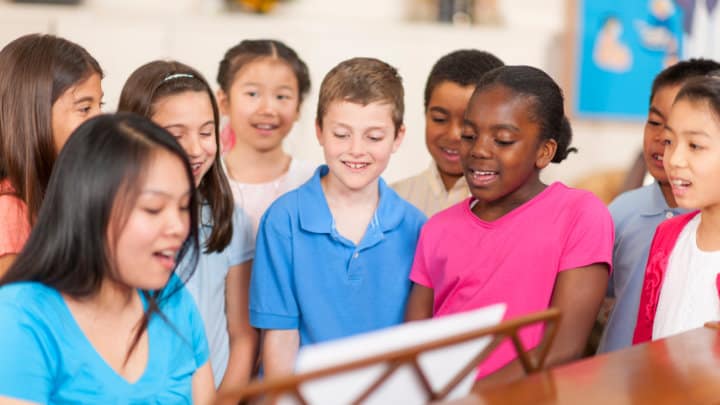
There are many wonderful worship songs out there to sing, hear, admire and inspire. For that matter, there are also abundant songs for kids to learn and sing. And modern Christian artists flood the radio with wonderful titles and varieties of music. But sometimes we forget how marvelous and insightful old hymns can be. We tend to see classic church songs as stuffy and boring, and ignore the remarkable stories many of them tell. Open the eyes of students to a new world of musical motivation by exploring the stories behind some old classics and examining their words.
Target Age range: Older elementary/ middle school, most likely
Open: First, identify current favorite songs and hymns that kids may have. Invite them to write or recite the words, identifying a theme or progression if possible. See if they know the artist or author.
Lesson: Provide students with examples of some classic beloved hymns and old hymn writers. Point out how poignant and meaningful the words are, and pay attention verse by verse to what the song really says. You may want to focus on a certain theme in particular, a certain writer, or the story behind an already well-known hymn. There is a vast array of possibility here, including…
-“Amazing Grace”… a classic and well-known song, but do we know the whole story? Author John Newton owned a slave ship and had wandered far from his faith prior to experiencing an amazing deliverance and writing the beloved hymn.
-“It is Well with my Soul”: this beautiful hymn, written by Horatio Spafford, was borne of intense tragedy. The author had been financially wiped out in the great Chicago fire, after which he lost his four daughters in a shipwreck. While passing the place where his daughters had perished, he was inspired by deep peace to write the song.
-“Come Thou Font of Every Blessing”: Here is another old classic, written by Robert Robinson, with some amazing verses echoing themes of the Old Testament. The words and tune have been altered in several variations, all of which are inspiring and amazing.
“Fairest Lord Jesus” (“Beautiful Savior”): originally written by German Jesuits and translated to English by Joseph Seiss, the awe-inspiring words of this song focus on attributes of Christ and how He cannot even compare with anything else in nature.
“Abide with Me”: The Scottish author of this hymn wrote the words as a poem just weeks before dying of tuberculosis. The hymn is about death, but it is not sad and gloomy. On the contrary, it is full of hope and confidence in the nearness of God in any circumstance. This song focuses on joy of life in Heaven, removing the fear and sting from death and replacing it with expectation of what is to come.
–Fanny Crosby (author) This “Happiest Creature in all the Land.” This prolific hymn writer was known for her joyful demeanor and outlook, but also for her distinguishing blindness. She saw this as a blessing rather than a trial, though, saying that she was glad to be born blind because when she arrived in Heaven, the Lord’s face would be the first she would see. Fanny is known for hymns like “Blessed Assurance,” “All the Way my Savior Leads Me,” “Rescue the Perishing,” and “Jesus is calling.”
–Isaac Watts (author) Watts was an eighteenth century pastor, poet, and hymn writer of England. He is sometimes considered the father of hymn writing. His over 600 titles largely celebrate God’s glory and celebrate His wonders. Popular titles include “When I Survey the Wondrous Cross,” “Come, We that Love the Lord,” “We’re Marching to Zion,” and “Joy to the World.” Many of his hymns we probably sing without even realizing it!
These are just a few possibilities. There is much to explore in the world of hymnody and immense treasure to uncover within the words of songs old and new. When approaching a hymn, you may want to go through verse by verse with students, looking at the words and then practicing singing the song. Give students a short “homework assignment” to select a hymn and come back with a brief background to learn more about it. You may even inspire a good old fashioned “hymn sing” with the whole class!
Compare the themes and stories behind these classic tunes with modern worship songs. It’s not that anything is wrong with our current church music style; words of worship are beautiful. But all too often current trends bear more a resemblance to romance than awe and worship…substitute “lover” for “Lord” and you might not even notice a difference in lyrics. Exploring songs from the past can be an inspiring gateway to worship and Bible Study.
Close out your hymn lesson with prayer that God would open eyes and hearts to His beauty, as well as helping to do all things for and with Him. Finish off with a song!
You can find many of these hymns performed on YouTube. We’ve compiled a few of our favorite hymns for children too.
Lesson: Amazing Grace and Teaching Children the Old Hymns
New Sunday School Curriculum: Our Bible lessons are designed to keep the kids’ attention and show how God's Word makes a difference. Every series is flexible enough for a wide-age group and affordable enough for small churches. Download a free Bible lesson in pdf or view our latest Sunday School curriculum for small churches.
